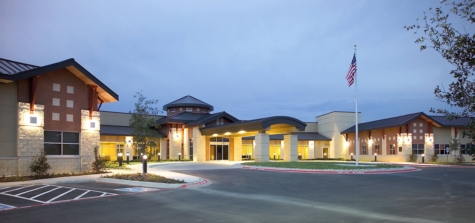Bringing hospital care at home to rural communities
Almost a year ago, leaders at North Texas Medical Center in Gainesville began evaluating hospital-at-home care in response to health care access issues in their rural service area, along with several studies showing hospital-at-home care improves patient satisfaction and health outcomes.
The process began with a thorough assessment of community needs and existing health care infrastructure. The evaluation indicated demand for both outpatient and inpatient hospital-at-home services and a need for external resources to manage the infrastructure, logistics, and training.
North Texas Medical Center adopted a phased approach to rolling out its hospital-at-home services, starting with outpatient therapy at home. Encouraged by their success and positive patient feedback, the rural hospital expanded the program to include primary care services followed by inpatient care, where patients requiring more intensive treatment, such as IV therapy or post-operative care, are admitted to a home-based inpatient hospital bed. This gradual implementation ensured each phase was carefully planned and executed, allowing North Texas Medical Center to refine its processes and address any challenges effectively.
The hospital-at-home model is adaptable and can be tailored to meet the unique demands of different rural settings.
Hospital-at-home care
Hospital at home is an innovative concept that started in urban centers and is making its way into the heart of rural America. The idea stemmed from the realization that patients in rural areas often face significant barriers to accessing regular treatment. Hospital at home bridges the access gap by offering high-quality care at the patient’s home (or nursing home or assisted living facility). Not entirely new, the concept has gained traction due to advancements in telemedicine and mobile health technologies.
 |
Hospital at home is distinct from traditional home health care administered to those who are sick or injured but don’t require hospitalization. Eligible hospital-at-home patients – those who meet clinical criteria, live a reasonable distance from the hospital, pass a home safety assessment, and meet other criteria – receive the same level of acute care as those admitted to hospitals, including diagnostic studies, therapies, and treatments. In fact, their official status is that of an inpatient in a licensed hospital bed — although they are monitored, cared for, and discharged at home.
Initial assessment and intake currently must take place at a hospital. A patient may avoid a traditional hospital admission altogether by transferring to hospital-at-home care directly from the emergency department, or an inpatient may complete their hospitalization at home once they are clinically ready and mobile medical equipment and other supports are in place.
What’s involved
There is no question that hospital at home improves patient outcomes and satisfaction while reducing cost. Although the implementation process is complex and may seem daunting for a community hospital with limited resources, the model is beneficial for the hospital and patients. Some requirements include IT infrastructure, CMS credentialing, and logistics for equipment, food, and staff. Many hospitals are partnering with service providers and taking a phased approach to introducing hospital-at-home services.
Requirements
To deploy hospital at home, a hospital must qualify for a CMS waiver. Yet the biggest challenge is assembling and orchestrating the array of moving parts, including supplies, staffing, ancillary services, and data streams. Information technology that is simple, effective, and integrated with the hospital’s electronic health record system is a foundational program component. At the center of it all is a communications and logistics hub that keeps tabs on everything, from vendor contracts to patient care coordination. The patient-facing tools must provide all functionality in an easy-to-access secure and trusted platform.
Types of services
There is almost no end to how the hospital-at-home toolkit can be adapted and applied. Implementation can be tailored to meet the unique demands of different rural settings. Some of the applications include:
- Inpatient care at home: This component is focused on patients who need hospital admission but could be safely treated at home. The model includes comprehensive services such as clinical care, dietary services, lab tests, and radiology, all provided at the patient's home. Hospitals must apply for a Medicare waiver and be accepted by CMS to offer this service.
- Outpatient therapy at home: This program addresses the need for physical therapy for patients unable to travel frequently to the hospital. By bringing therapy services to patients' homes, the model improves patient compliance and health outcomes. It also provides a new revenue stream for the hospital through outpatient billing, which is supported by existing Medicare regulations.
- Primary care at home: This modern-day house call model can be offered through a hospital’s rural health clinic. It’s helpful to find an existing practitioner who is ready to transition their practice to visiting patient homes. This service enhances continuity of care for patients with chronic conditions, ensuring they receive regular medical attention without the need to travel.
- Infusion services at home: The same hospital-at-home tools can be used to bring chemotherapy infusion or other medication infusion services to patients in their homes. Many patients appreciate the need to receive needed medication in a more comfortable environment.
The hospital-at-home model represents a significant advancement in rural health care that addresses longstanding access issues. By bringing comprehensive care directly to patients' homes, this model may improve health outcomes, increase patient satisfaction, and provide a sustainable approach for rural health care providers.
NRHA adapted the above piece from Community Hospital Corporation, a trusted NRHA partner, for publication within the Association’s Rural Health Voices blog.
 | About the author: Brian Doerr, an expert in healthcare technology and hospital at home implementation, serves as senior vice president of information technology & security and privacy officer at Community Hospital Corporation. He is responsible for developing and implementing IT, security, and privacy programs for hospital clients. His expertise makes him a valuable asset to rural hospitals seeking innovative and efficient healthcare solutions. |
